WORLD MUSIC TRADITIONS - ISLAM AND THE ARABIC WORLD
Little visited these days by Western travelers, Iran, a country the size of Alaska or Quebec, is home to nearly seventy million people. Because much of the country is mountainous and rainfall is scanty except along the Gulf of Oman coast, Iran’s large population often has to cope with difficult and dangerous conditions. Earthquakes are a constant concern in many areas, and when one occurs, typically large numbers of people die.
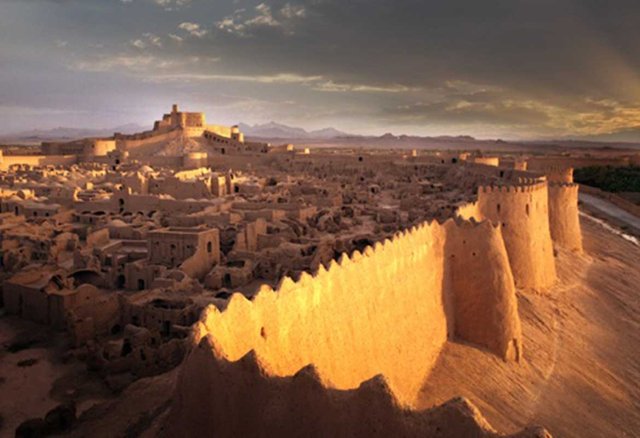
Iran, known as Persia until the twentieth century, is different from most of its neighbors on several accounts. The vast majority of its inhabitants share a non-Arab origin and speak Farsi, an Indo-European language related to that of the Kurds, who live at the juncture of Iran, Turkey, and Iraq. Most of Iran’s population is Shia Muslim, Shia being the division of Islam that in many places is associated with the lower economic classes and that tends to express itself more emotionally and militantly than Sunni Islam, which has become the mainstream form of Islam in most Middle Eastern countries. Shia Islam has a more developed clergy, the lower-ranking members being called mullahs and the higher-ranking ones ayatollahs. At various times, the more radical manifestations of the group’s fundamentalist tendencies, such as the 1979 Iranian hostage crisis, have strained political relations between people and governments not only in the West but also among non-Shia Muslims and neighboring countries as well.
Persia has a long history, from its first flourishing in the sixth century B.C.E. under Cyrus the Great, through its periods of subjugation by Alexander the Great, the Parthians, the Turks, and the Mongols, to independence in the eighteenth century. Some consider its greatest period to have been during the rule of the Sasanian dynasty (third to seventh centuries C.E.). Modern Iran was created in the early twentieth century, along with a hereditary line of rulers called shahs, the last being Shah Muhammad Reza Pahlevi, who ruled until deposed by a revolution in 1979. Since 1979 Iran has been a theocratic democracy, ruled by an uneasy union of semi-official ayatollahs and official secular leaders.
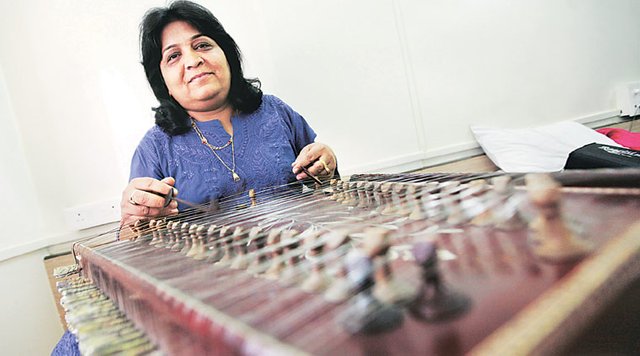
The Santoor
Iranian classical music often has a melancholy mood. The instrumentalist in this example express this quality through pitch, rhythm, and dynamics, encouraging an intimate atmosphere that is typical of Persian classical performance. It begins with a stringed instrument playing a rhythmically free melody in an improvisatory manner, who continues the rhythmically free approach. Despite the apparent similarities between Arabic and Iranian music (or, more properly, Persian music), however, the two systems are conceptually quite different.
A careful listener will detect a percussiveness that distinguishes it from the plucked instruments. Indeed, the player is using two small wooden hammers to strike the strings. Organologically, such an instrument is called a “dulcimer” or a “hammered zither,” because the strings are parallel to a soundboard without a neck, and struck by mallets. The instrument is a Persian Santoor, Iran’s most distinctive and centrally important instrument. It is also considered by academics as the predecessor of the rest of the world’s dulcimers, which are distributed as far as China and Korea in the east, Thailand and Vietnam in Southeast Asia, and Europe and the United States in the West. Indeed, some scholars even consider the European piano to be inspired in part by the santoor, because pianos work on the same principle of sound production, except that keys flip the hammers against the strings.
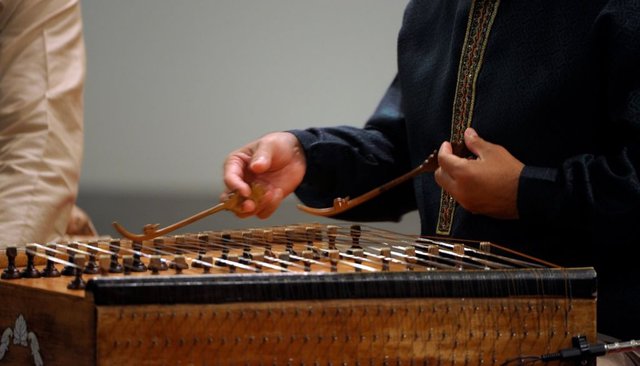
The santoor is constructed of a hardwood, trapezoidal-shaped body with a lower side around 3 feet (91 cm) in length and an upper side only around 14 inches (35 cm) across. Courses—groups—of four strings each stretch from tuning pins on the right over two rows of moveable bridges, in rows of thirteen and twelve respectively, to tunable anchor pins on the left. Players hammer the strings near the bridges on either side of the left row and on the left side only of the right row of bridges. If plain wooden hammers are used, the tone is more percussive than when players cover the mallet tips with felt or cloth, as is the case in our example. The santoor, in slightly different forms, is also played in other Middle Eastern countries, though elsewhere it is not the centrally important instrument it is in Iran. Iconographical evidence dates the santoor at least to the Babylonian period (1600–911 B.C.E.).
Persian music, like Arabic music, is based on an elaborate modal system (recall that the term mode refers to a “composition kit” used in improvisation), which in Persian music is called dastgah (plural, dastgah-ha). Officially there are twelve dastgah, each having seven pitches, plus a number of sub-modes called avaz.
There are, however, essential differences between the Arabic maqam and Persian dastgah systems. Unlike Arab musicians, who rely on an oral tradition of melodic phrases appropriate to a specific mode, Persian musicians have created a vast body of “composed” melodic phrases that amount to short compositions; these are called gusheh. Each dastgah, then, is learned by memorizing a variable number of these short gusheh compositions that can then be strung together to create a longer and more complete performance/composition. Groups of gusheh are organized around specific pitches of the dastgah, allowing the player to progress from the lowest (or home) note, called the ist, to higher pitches, where the musical tension becomes greater. The number of gusheh employed in any particular performance depends on the performer’s knowledge and needs, while the specifics of the gusheh used vary according to the player’s “school” (or tradition). For pedagogical purposes, as well as to set a kind of national standard, scholars have collected and printed all the gusheh for all the dastgah in a book called the radif. Therefore, a student can memorize as many gusheh as might be needed for performance, but the radif itself differs from “school” to “school” (“school” being the tradition of a single master).
A complete performance of a dastgah typically unfolds in several sections and requires a substantial amount of time, because the sections can be quite different from each other. A typical performance’s opening movement, called the daramad, is rhythmically free and emphasizes the lower-pitched gusheh. Following this is the tahrir, another section in free rhythm emphasizing melismatic melodic work. Then follow two metered pieces called kereshmeh and chahar-mezrab respectively, which are followed in turn by a repetition of the rhythmically free daramad.
Although the santur is probably Iran’s most distinctive instrument, as we see in the previous performance, other kinds of instruments are important as well. These include two plucked lutes, the sehtar and the tar. The latter’s skin-covered body has a distinctive shape, resembling the number “8.” Also important is the round-bodied bowed lute called kemancheh. One aerophone, the ney, an end-blown notch flute found throughout the Middle East, is commonly heard. The main percussion instrument is a goblet-shaped, single-headed drum called the dombak or zarb, which resembles the Arabic darabuka.
Sethar
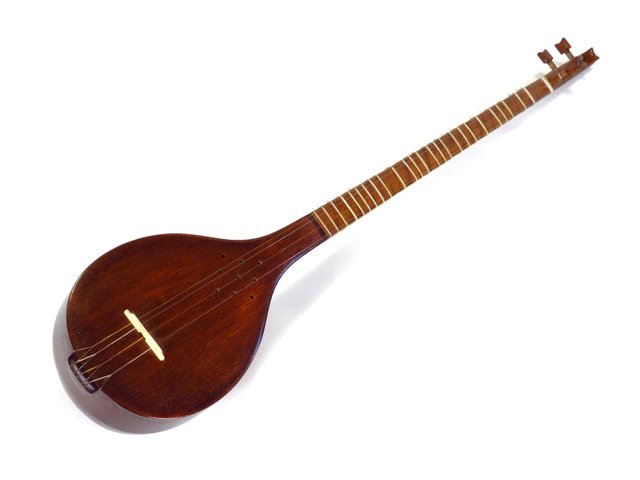
Tar
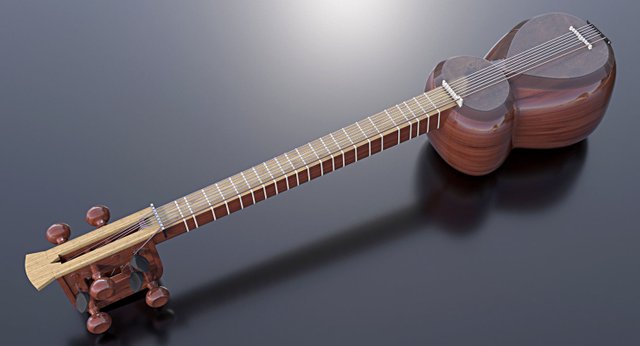
Kemancheh

Ney
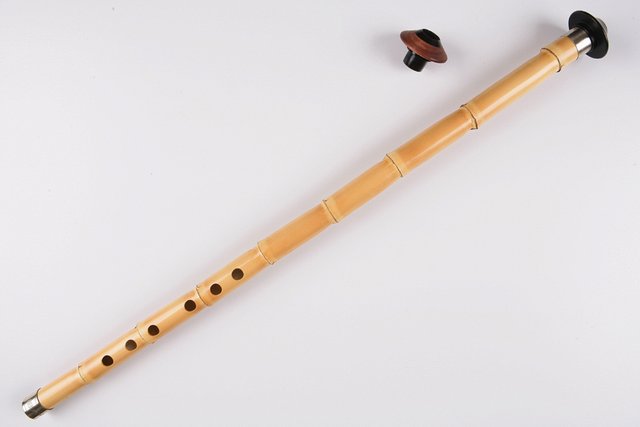
Dombak or Zarb
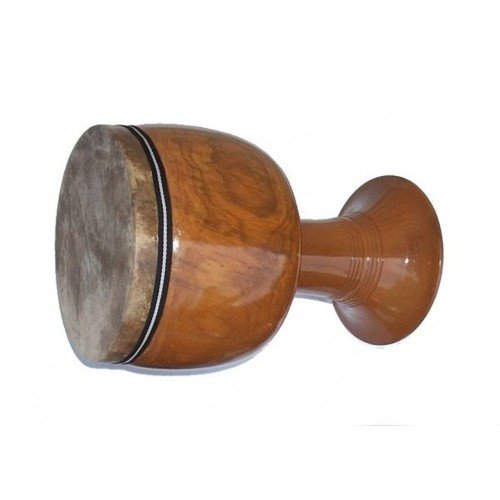
Cultural Considerations
The classical dastgah-ha of Iran form a vast and flexible system, which allows musicians to create both fixed compositions and improvisations by stringing together numerous short compositional blocks. Naturally, this system also calls for an element of individual creativity, because Persian music-making is about far more than building Lego- like performances. The art comes in how the gusheh are joined to each other and in how they are subtly changed and elaborated. Because musicians belong to various “schools” and The Persian santur (dulcimer) consequently have learned different approaches to the dastgah, specific gusheh generally sound different from one performance to another. The use of measured rhythm in metrical cycles is no longer as significant in Persian music as it once was, and the metered pieces found in suites, such as the chahar-mezrab, employ fairly simple rhythmic patterns. While foreign audiences generally prefer the metered compositions because of their use of one or more drums and their steady beat, Persian musicians and connoisseurs value rhythmically free improvisations most highly for the display of refined musicianship they allow.
Example of the Chahar-Mezrab
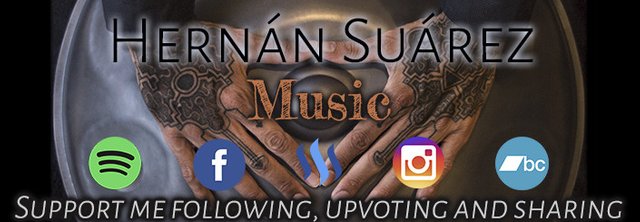
🎶🎵Sharing my music all around the world! 🎵🎶
Spotify
Facebook
Steemit
Instagram
Awesome article, very nice work. Thank you for the time and perspective. I look forward to my first visit to Iran.
Hello @nadabrahmasounds, thank you for sharing this creative work! We just stopped by to say that you've been upvoted by the @creativecrypto magazine. The Creative Crypto is all about art on the blockchain and learning from creatives like you. Looking forward to crossing paths again soon. Steem on!